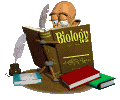| Chapter
Objectives
- List the characteristics
of protists
- Briefly summarize and
compare the 2 major models of eukaryotic origins
- autogenous hypothesis
- endosymbiotic hypothesis
- Provide 3 lines of evidence
for the endosymbiotic hypothesis
- Explain why some critics
are skeptical about the bacterial origins for chloroplasts
and mitochondria
- Explain why modern biologists
recommend expanding the original boundaries of the Kingdom
Protista
- Explain what is meant
by the statement: Kingdom Protista is a polyphyletic group
- List 5 candidate kingdoms
of Protists and describe a major feature of each
- Describe amoeboid movement
- Outline the life cycle
of Plasmodium
- Indicate the organism
that causes of African sleeping sickness and explain how it
is spread and why it is difficult to control
- Describe the function
of contractile vacuoles in freshwater ciliates
- Distinguish between
macronuclei and micronuclei
- Use diagrams to describe
conjugation in Paramecium caudatum
- Explain how accessory
pigments can be used to classify algae and determine phylogenetic
relationships among divisions
- Distinguish among the
following algal groups based upon pigments, cell wall components,
storage products, reproduction, number and position of flaglla,
and habitat
- Dinoflagellata
- Bacillariophyta
- Chrysophyta
- Phaeophyta
- Rhodophyta
- Chlorophyta
- Describe 3 possible
evolutionary trends that led to multicellularity in the Chlorophyta
- Outline the life cycles
of Chlamydomonas, Ulva, and Laminaria
and indicate whether the stages are haploid or diploid
- Distinguish between
- isogamy and oogamy
- sporophyte and gametophyte
- isomorphic and heteromorphic
generations
- Compare life cycles
of plasmodial and cellular slime molds and describe the major
differences between them
- Provide evidence that
the oomycetes are not closely related to fungi
- Give examples of oomycetes
and describe their economic importance
- Explain the most widely
accepted hypothesis for the evolution of multicellularity
|
| Chapter
Terms:
| acritarchs
protozoa
algae
syngamy
plankton
serial endosymbiosis
flagellates
Euglenozoa
euglenoids
kinetoplastids
Alveolata
dinoflagellates
apicomplexans
sporozoites
ciliates
conjugation |
pseudopodia
detritus
amoebas
heliozoans
radiolarians
forams
plasmodial slime molds
cellular slime molds
Stramenopila
diatoms
golden algae
water mold
white rust
brown algae
thallus
holdfast |
stipe
blades
alternation of generations
sporophyte
gametophyte
heteromorphic
isomorphic
red algae
green algae
lichens
diatoms
laminarin
isogamy
anisogamy
oogamy
heterogamy |
|
| Chapter
Outline Framework
- Introduction
to the Protists
- Protists are the
most diverse of all eukaryotes
- Symbiosis was involved
in the genesis of eukaryotes from prokaryotes
- Protist Systematics
and Phylogeny
- Monophyletic taxa
are emerging from modern research in protist systematics
- Members of candidate
Kingdom Archaezoa lack mitochondria and may represent
early eukaryotic lineages
- Candidate Kingdom
Euglenozoa includes both autotrophs and heterotrophic
flagellates
- Surface cavities
(alveoli) are diagnostic of candidate Kingdom Alveolata
- A diverse assemblage
of unicellular eukaryotes move by means of pseudopodia
- Slime molds have
structural adaptations and life cycles that enhance their
ecological role as decomposes
- Diatoms, golden
algae, brown algae, and water molds are members of the
candidate Kingdom Stramenopila
- Structural and biochemical
adaptations help seaweeds survive and reproduce at ocean
margins
- Some algae have
life cycles with alternating multicellular haploid and
diploid generations
- Red algae (candidate
Kingdom Rhodophyta) lack flagella
- Green algae and
plants probably had a common photoautotrophic ancestor
- Multicellularity
originated independently many times
back
to top |
|

